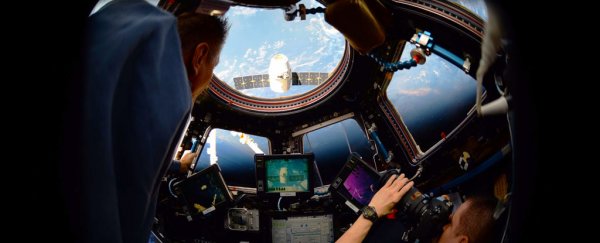When you're away from home, care packages matter. But nothing quite says 'we care' like fresh ice cream launched into Earth's orbit by a SpaceX rocket.
In the most ambitiously orchestrated snack delivery in human history, astronauts on board the International Space Station (ISS) have received a shipment of ice cream from home – and not that freeze-dried 'astronaut ice cream' stuff either, this frozen treat is the real deal.
The off-Earth care package came courtesy of SpaceX's CRS–12 resupply mission that launched this week from NASA's Kennedy Space Centre in Florida, docking with the ISS's Harmony module on Wednesday after a 36-hour flight.
The payload carried more than 2,900 kilograms (6,400 lbs) of research equipment, cargo, and supplies to support over 250 research projects.
These include an experiment tracking the growth of protein crystals in space that could aid our understanding of how Parkinson's disease works, a 'Spaceborne Computer' designed to see how supercomputers fare on long-haul space jaunts, and an ISS-CREAM instrument (no relation to the ice cream) to measure cosmic ray particles.
But, of course, as far as any astronaut sweet tooths are concerned, the real kicker is dessert. So what kind of ice cream can scientists on board the ISS look forward to digging into?
The space agency's official ISS blog explains the "sweet treat" includes "small cups of chocolate, vanilla, and birthday cake-flavoured ice cream", but doesn't elaborate on any further details.
Luckily for those curious about these things, the manager of NASA's Space Food Systems Laboratory, Vickie Kloeris, was a bit more forthcoming to NPR.
According to Kloeris, astronauts will get to snack on 30 individual cups of Blue Bell ice cream and some Snickers ice cream bars. Not a bad haul, but the shipment comes with a tantalising condition attached: snack quickly.
The time limit is due to the month-long window in which SpaceX's Dragon capsule will remain docked to the ISS.
While there have been over 100 uncrewed supply missions to the ISS to date, it's only in the modern SpaceX era of reusable spacecraft like the Dragon, that perks like ice cream are possible.
How come? Because on previous supply runs, the craft used couldn't return to Earth without burning up.
Because SpaceX's fleet has been designed around reusable vessels that can safely return to Earth, it means the Dragon can act like a taxi, ferrying cargo to the ISS, and then returning scientific samples and experiments back to Earth's surface.
But to do that, the Dragon's freezer space needs to be cleared out within one month so it's got space for everything it's taking back to Earth.
For astronauts, this is a good problem to have.
"It's a really special treat, but when it gets there, they have no place to put it," Kloeris told NPR.
"It's tough duty, but they'll manage to eat it in the time allowed."
In addition to frozen foods, astronauts get to nominate what kind of snacks they receive in their "fresh-food kit".
On this occasion, the crew only asked for coffee and condiments, so Kloeris threw in some unrequested avocados and apples.
On other hauls they receive things like tortillas, toilet paper (Americans are said to prefer a softer texture than their cosmonaut comrades), and fresh socks.
With the exception of occasional treats and fresh-food kits, Kloeris's lab has developed a largely standardised menu for astronauts on the ISS, rather than letting them pick and choose their own food, which they once got to do.
That practice ended with the closure of the Space Shuttle program in 2011 – a side effect of which was that astronauts and their food choices ended up aboard the ISS at different times, meaning scientists inevitably ended up poaching each other's food, sometimes out of necessity.
"That became a huge psychological issue," Kloeris said. "We had so many complaints."
